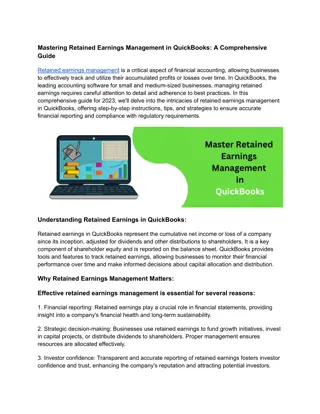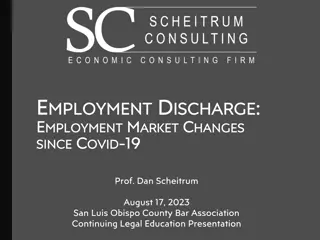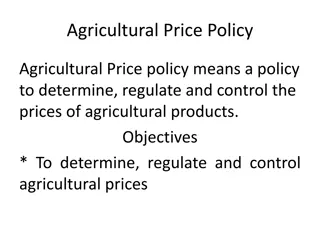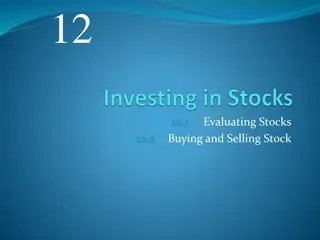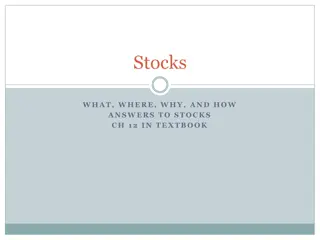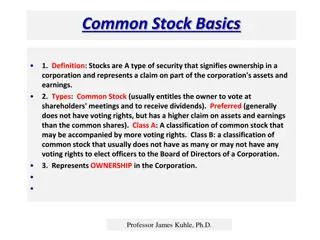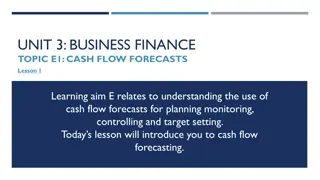Stock Prices and Future Earnings: A Study on Accruals and Cash Flows
This study by Richard G. Sloan and Zhengying (Vivien) Fan explores whether stock prices fully reflect information in accruals and cash flows concerning future earnings. The research develops hypotheses, examines sample data, and conducts empirical analysis to assess the relationship between earnings components and stock returns. Findings suggest that investors may not fully discern between earnings components, influencing stock price predictability and abnormal returns based on accrual levels.
Download Presentation

Please find below an Image/Link to download the presentation.
The content on the website is provided AS IS for your information and personal use only. It may not be sold, licensed, or shared on other websites without obtaining consent from the author.If you encounter any issues during the download, it is possible that the publisher has removed the file from their server.
You are allowed to download the files provided on this website for personal or commercial use, subject to the condition that they are used lawfully. All files are the property of their respective owners.
The content on the website is provided AS IS for your information and personal use only. It may not be sold, licensed, or shared on other websites without obtaining consent from the author.
E N D
Presentation Transcript
Do Stock Prices Fully Reflect Information in Accruals and Cash Flows about Future Earnings? ---Richard G. Sloan Zhengying (Vivien) Fan Topics in Quantitative Finance Washington University in St. Louis Sep 16, 2015
Outline Introduction Development of Hypotheses Sample Formation and Variable Measurement Empirical Analysis Conclusions
Introduction This paper contributes in three key respects: Employs a model that relies on characteristics of the underlying accounting process that are documented in texts on financial statement analysis Uses a less restrictive model that assumes investors might not fully discriminate between different components of earnings Assesses the extent to which the magnitude of the predictable stock returns is consistent with the predictions of the na ve earnings expectations model
Development of Hypotheses H1: The persistence of current earnings performance is decreasing in the magnitude of the accrual component of earnings and increasing in the magnitude of the cash flow component of earnings. H2(i): The earnings expectations embedded in stock prices fail to reflect fully the higher persistence attributable to the cash flow component of earnings and the lower earnings persistence attributable to the accrual component of earnings.
Development of Hypotheses H2(ii): A trading strategy taking a long position in the stock of firms reporting relatively low levels of accruals and a short position in the stock of firms reporting relatively high levels of accruals generates positive abnormal stock returns. H2(iii): The abnormal stock returns predicted in H2(ii) are clustered around future earnings announcement dates.
Sample Formation and Variable Measurement 40679 firm-year observations from 1962 to 1991
Empirical Analysis: Test of H1 High Earnings Portfolio Time series properties of Earnings, Accruals and Cash Flows. Year 0 is the year in which firms are ranked and assigned in equal numbers to ten portfolios based on each of three respective variables. Low Earnings Portfolio High Cash Flow Portfolio High Accrual Portfolio Low Accrual Portfolio Low Cash Flow Portfolio
Empirical Analysis: Test of H2(i) Basic implication of market efficiency: (3) A model that satisfies the efficient-markets condition: (4) (1) (5) (2) (6)
Empirical Analysis: Test of H2(ii) Returns of Hedge Portfolio
Conclusion The persistence of earnings performance is shown to depend on relative magnitudes of the cash and accrual components of earnings. Stock prices act as if investors fail to identify correctly the different properties of these two components of earnings. Additional issues for further research
Comments This paper considered only current accruals those arise mostly due to timing of payments and expenses. Sloan published a follow-up study Accrual Reliability, Earnings Persistence and Stock Prices . It looked at all accruals, but not just current ones.







